C
LAB WORKSHEET 7_1
A C & C++ Repetition: The for Loop 2
http://www.tenouk.com/clabworksheet/labworksheet7_1.html
Items in this page:
-
More for loop exercises, questions and answers.
-
The related tutorial reference for this worksheet are: C & C++ program control 1 and C/C++ program control 2.
printf("%d\t",
i + 1);
|
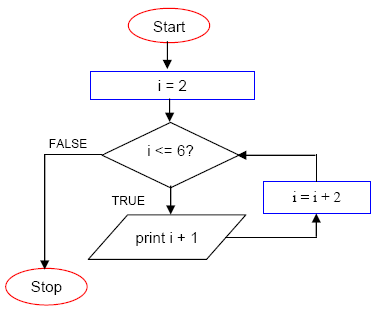  |
printf("%d\t",
i + 1);
|
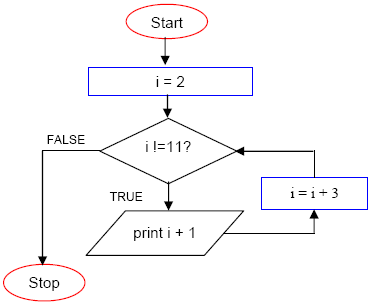  |
printf("%d\t",
i + 1);
|
  |
printf("%d\t",
i + 1);
|
  |
printf("%d\t",
i + 1);
|
  |
|
|
|
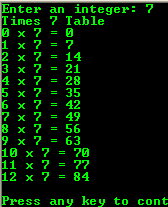 |
| |
|
|
#include <stdio.h>
void main()
{
int i = 0, x =
0, y = 0, sum = 0;
printf("Enter
a small integer: ");
scanf_s("%d",
&x, sizeof(int));
printf("Enter
a bigger integer: ");
scanf_s("%d",
&y, sizeof(int));
for(i = x; i >=1;
i = i -1)
sum = sum + y;
printf("Product
of %d and %d is %d\n.\n", x, y, sum);
}
 |
|
/* Print out all integers from 5
down to -5 */
#include <stdio.h>
void main()
{
int i;
for(i = 5; i >=-5;
i = i-1)
printf("%d ",
i);
printf("\n");
}
 |
|
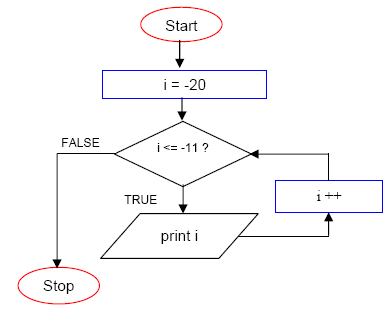
/* Print out all integers from -11
down to -20. */
#include <stdio.h>
void main()
{
int i;
for(i = -20; i
<=-11; i++)
printf("%d ", i);
printf("\n");
}
 |
|
 |
|

/*
Print out the squares of the first
10 integers */
#include <stdio.h>
void main()
{
int i;
for(i = 0; i <=
10; i++)
printf("%d ", i*i);
printf("\n");
}
 |
|
|
|
|
#include <stdio.h>
void main()
{
int i;
// first day got 10 cent
double sum = 0.10;
// start on 2nd day, got twice
for(i = 2; i <=
15;)
{
// the next day got twice the previous day
sum = sum + sum;
printf("Total money for day %d is USD%.2f\n", i, sum);
// after complete the calculation, go to the
next day
i++;
}
}
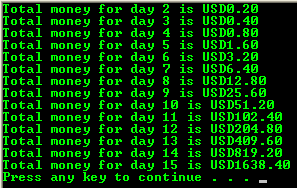 |
More Example And Practice
-
All loops must start somewhere; this called the initialization of the loop. They must stop sometime, the termination of the loop, or else they keep executing, resulting the infinite loop (use CTRL-C to terminate the program for PC compatible). To terminate a loop, we will need to evaluate conditions, for example, whether a variable is equal to a value or not. Furthermore, while the loop is going through its iterations, it must come closer and closer to the terminal condition.
|
 |

-
The previous code illustrates a very simple loop. The numbers in the comments identify selected statements. A tracechart is shown alongside the code. In step 1 of the trace, statement 1 of the code is executed, that is 1 is assigned to i. In statement 2 a question is asked. Is i less than or equal to 2? Yes, so the loop, which is composed of the two statements inside the set of braces, is executed. Statement 3 shows that i, with a value of 1, is printed and then i is incremented to 2. Here, we draw a horizontal line in the tracechart to depict that the execution goes up to the for statement.
-
In step 5, is i less than or equal to 2? Yes, so we go through the loop again, printing 2 for i and incrementing it to 3. Now we have complemented the second iteration of the loop. In step 8, checking to see if i <= 2, we see that it is false and we stop the loop. The flowchart is given below.
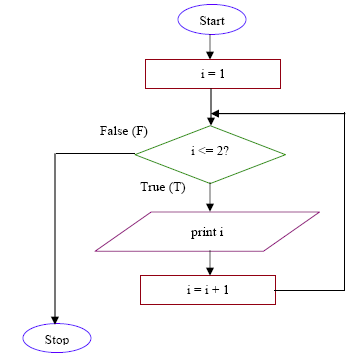 |
|
-
The flowchart starts at the oval labeled Start and ends at the one labeled Stop. A rectangle is used for assignments. i is assigned 1 to begin. Then we encounter a decision diamond. Here we take the T for the true route and fall into the loop until the condition of i <= 2? becomes false, where we stop.
-
With a minimum number of changes, convert this flowchart so that all the integers from 3 to 7 are printed and write the code.
-
Write the code and draw the flowchart that will print 3, 5 and 7 instead of 3, 4, 5, 6 and 7. From the flowchart write the tracechart.
-
You can show the iteration number of the loop by modifying the previous program as shown below.
|
 |
|
Write a program that will ask the user to
give three integers. Call these integers
start,
step_by and
stop.
After these three integers are scanned in, set up the
for
loop that will start
i
at the value of
start,
make it increase by the value given by
step_by
and make it stop at the value stored in
stop.
Print these values as shown in the following output sample.
-----------Output---------------
Enter three integers: 23 3 32
23 26 29 32
|
#include <stdio.h>
void main()
{
int i, start =
0, step_by = 0, stop =0;
printf_s("Enter
three integers: ");
scanf_s("%d %d
%d", &start, &step_by, &stop);
for(i = start;
i <=stop; i = i + step_by)
printf("%d ", i);
printf("\n");
}
 |
|
Write a program that will add up all the
integers from
1
to the integer that was scanned into the variable
j.
Store the sum in the variable called
sum
and use
i
to increment the integers from
1 to
j.
Print only
sum.
For example, if
5
were read into
j,
then sum would be
1 + 2 + 3 + 4 + 5
or
15.
A sample output is given below.
---------Output----------------
Give an integer: 6
Sum of integers from 1 to 6 is 24.
|
#include <stdio.h>
void main()
{
int i, j, sum
= 0;
printf_s("Give
an integer: ");
scanf_s("%d",
&j);
for(i = 1; i <=j;
++i)
sum = sum + i;
printf("Sum of
integers from 1 to %d is %d\n", j, sum);
}
 |
The Nested Loop: Loop in Loop
-
The for loop and all other repetition constructs can also be nested to any degree. In a simple word, nesting means loop in loop. Let try the following program example.
|
// a program to show the nested for loops
#include
<stdio.h>
int main()
{
// variables for counter…
int i, j;
// outer loop, execute
this first...
// for every i iteration,
execute the inner loop
for(i=1; i<10;)
{
// display i
printf("%d",
i);
// then, execute inner
loop with loop index j the initial value of j is i + 1
for(j=i+1;
j<10; )
{
// display result of j
iteration
printf("%d",
j);
// increment j by 1 until
j<10
j = j + 1;
}
// go to new line
printf("\n");
// increment i by 1, repeat
until i<10
i = i + 1;
}
return 0;
}
|
 |
-
The program has two for loops. The loop index i for the outer (first) loop runs from 1 to 9 and for each value of i, the loop index j for the inner loop runs from i + 1 to 9. Note that for the last value of i (i.e. 9), the inner loop is not executed at all because the starting value of j is 10 and the expression j < 10 yields the value false because j = 10.
-
The following is another nested example; study the program code and the output. In general, a nested two for loops can be depicted as a row and column.
|
 |
-
The first for loop is executed until the row is 1 (row > 0). For every row value, the inner for loop will be executed until col = 1 (col > 0). In a simple word, the external for loop will print the row and the internal for loop will print the column.
-
For the previous two nested for loop program example, build the flowcharts. Ans: as shown below.
 |
 |

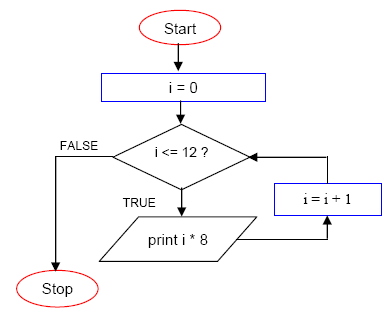

No comments:
Post a Comment